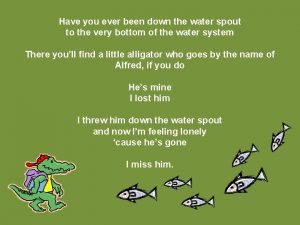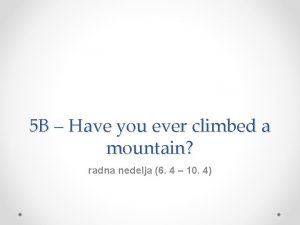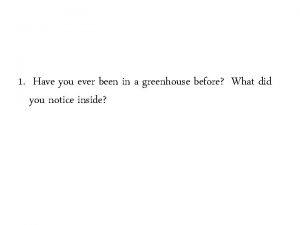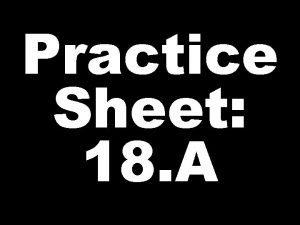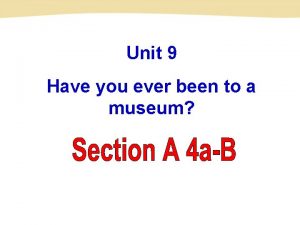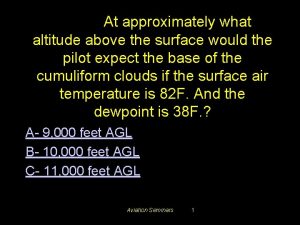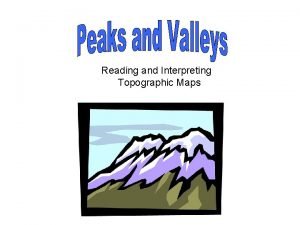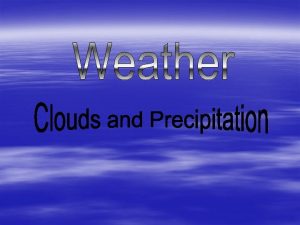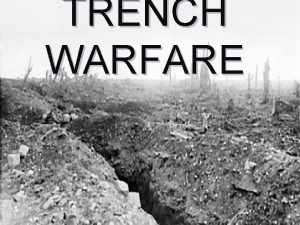Have you ever just looked at clouds Why






































































- Slides: 70


Have you ever just looked at clouds? § Why do we have clouds? § Why are there different shapes? § What can they tell us about the weather?

Take Good Notes! § There will be a quiz on this information

Understanding Clouds § Clouds form as warm air is forced upward § As the air is forced upward, it expands and cools

Fronts and Air Masses § An air mass is a large body of air whose temperature and moisture are fairly similar at a given altitude § Fronts are boundaries separating different air masses § There are four different air masses that affect the United States

The Air Masses § c. P( continental polar) : cold, dry stable § c. T( continental tropical) : hot, dry, stable air aloft, unstable at the surface § m. P( maritime polar) : cool, moist, unstable § m. T( maritime tropical) : warm, moist, unstable

This map shows the air mass source regions and there paths

Ok, now we see the difference in the air masses § Let’s look at the different fronts and their impact on weather § Can you see the four different types of fronts on the map?

Warm Fronts § A warm front is warm air displacing cool air diagram § Shallow leading edge warm air must “overrun” cold air § These are usually slow moving

Cold Fronts § Cold air advances into region of warm air § Intensity of precipitation greater, but short lived § Clearing conditions after front passes § Usually approaches from W or NW

Stationary Fronts § Surface positions of the front do not move § Often a region of clouds

Occluded Fronts § Cold front overtakes warm front § Often found close to the low pressure center


Pressure’s Affect L H L


WRECCC Clouds Condenses Cools Expands Rises Warm Air

How Else Can Clouds Form? § Fronts: When a WARM FRONT RISES OVER A COLD FRONT. This produces non violent rain showers.

§ Fronts: When a COLD FRONT RISES OVER A WARM FRONT. This produces possibly violent rain storms very quickly, but is brief and may last only part of the day.


Before Cold Front After Cold Front

§ Orographic Uplift: When air is forced up the side of a mountain or plateau. The air forced up then cools down very quickly and condenses to form rain clouds.


Understanding Clouds § As the air cools, the relative humidity reaches 100% § For more information on Relative Humidity click ☼

Water vapor begins to condense in tiny drops around nuclei. Nuclei are small particles of dust, salt, and smoke in the atmosphere

Cloud Types § There are many different cloud types

Cloud Types § Can you think of the two main ways that clouds are classified? § Shape, Height, and sometimes Rain Capacity

By Shape! § There are three main cloud types that are based on shape § Think you know any of them? § Stratus § Cumulus § Cirrus

Stratus Clouds § Stratus clouds form a smooth, even sheet § They usually form at low altitudes

Stratus Clouds § When air is cooled and condenses near the ground, a stratus cloud know as _______ forms § Know the name?


Fog § Fog forms when a cold surface cools the warmer moist air above it. § What is water vapor doing in the air to form fog? – Condense § At what temperature does the air hit to condense as fog? – Dewpoint

Cumulus Clouds § These are masses of puffy, white clouds, often with flat bases § They form when air currents rise

Cumulus Clouds § They can be associated with both fair weather and……. when they get really tall!? !? !

Thunderstorms!

Cirrus Clouds § Cirrus clouds are high, thin, white, feathery clouds containing ice crystals

Cirrus Clouds § Cirrus clouds are usually associated with fair weather, but they may indicate approaching storms

By Height § The prefix of cloud names can describe the height of cloud bases § Cirro: High clouds above 6000 m

By Height § Alto: Middle elevation clouds between 2000 to 6000 m § Strato: Low level clouds below 2000 m

Rain Clouds § Nimbus clouds are dark clouds associated with precipitation

Rain Clouds § When a nimbus cloud is also a towering cumulus cloud, it’s called a cumulonimbus cloud

Ready for a quick review? § 1. Clouds can form when the relative humidity reaches ____% § 2. In order for clouds to form, water vapor begins to condense around ____of dust, salt, and smoke

§ 3. Clouds are classified by ____ and sometimes rain capacity § 4. Puffy, white clouds are called? § 5. Mid elevation clouds between 2000 and 6000 m

Let’s see how you did! 1. 100 2. Nuclei 3. Shape and height 4. Cumulus 5. Alto

Forms of Precipitation § Precipitation (pre-sip-uh-tayshun) is any form of water that falls to the Earth's surface.

Types of Precipitation § The type of precipitation that falls to the ground depends upon the formation process and the temperatures of the environment between the cloud and the surface

Can you name the different types of precipitation? § Rain § Snow § Hail § Sleet § Freezing Rain

Rain develops when growing cloud droplets become too heavy to remain in the cloud and as a result, fall toward the surface as rain §

§ Rain can also § As the falling begin as ice snow passes crystals that through the collect each other freezing level into to form large warmer air, the snowflakes melt

Rain from snow!

Snow § Snow is formed when ice crystals form from water vapor that is in the clouds directly above your heads! § This process is called sublimation


Hail § Hail is formed when updrafts carry raindrops upwards into extremely cold areas of the atmosphere

Hail § There the raindrops merge and freeze. When the frozen clumps get to heavy they fall to earth

Hail § Hail can vary in size, from the size of a small stone to that of a baseball! So be careful

Sleet § Sleet is frozen raindrops. Sleet begins as rain or snow and falls through a deep layer of cold air that contains temperatures below freezing that exist near the surface.

Sleet § Rain that falls through this extremely cold layer has time to freeze into small pieces of ice

Freezing Rain § Freezing rain is falling rain that cools below 0°C, but does not turn to ice in the air § The water is “supercooled”

When the drops hit anything they instantly turn to ice!


1. Nuclei for the formation of rain drops can be small particles of: A) salt, B) smoke, C) dust, D) all the above 2. Which of these cloud types is not based on the clouds shape: A) stratus, B) nimbus, C) cumulus, D) cirrus

3. Mid elevation clouds between 2000 and 6000 m: A) nimbus, B) alto, C) cirro, D) strato 4. This form of precipitation is supercooled: A) rain, B) snow, C) sleet, D) freezing rain

5. This form of precipitation stays frozen all the way to the ground: A) rain, B) snow, C) sleet, D) freezing rain Let’s see how you did!

The Answers! 1. D 2. B 3. B 4. D 5. B


Humidity and Relative Humidity § Humidity is the amount of water vapor in the air § Relative humidity is a measure of the amount of water vapor that the air is holding, compared to the amount it can hold at a specific temperature

Humidity and Relative Humidity § When the air is holding as much moisture as it can, it’s said to be saturated

Can you explain this graph?

§ In the cool of the morning, the air can’t hold as much moisture. We often have dew on a summer morning § Once the air has warmed, the relative humidity drops since the air can hold more moisture

You’ve seen water on the outside of a cold drink? § The cold air around the glass causes a lower temperature at which the air is saturated

You’ve seen water on the outside of a cold drink? § The temperature at which air is saturated and condensation takes place is the dew point § To return click here ☼
 A long narrow coiled tube where digestion is completed
A long narrow coiled tube where digestion is completed Have you ever looked in the mirror and thought
Have you ever looked in the mirror and thought Ever ancient ever new
Ever ancient ever new Have you ever wondered why some people
Have you ever wondered why some people Hey hey bye bye
Hey hey bye bye Ever ancient ever new
Ever ancient ever new Clarified it
Clarified it Ever tried ever failed no matter
Ever tried ever failed no matter Have you ever done something dangerous
Have you ever done something dangerous Have you ever wondered
Have you ever wondered Walmart shrinkage statistics
Walmart shrinkage statistics Have you ever read
Have you ever read Folkways
Folkways Have you ever climbed a mountain
Have you ever climbed a mountain Chipper chopper joe
Chipper chopper joe Have you ever ridden a camel?
Have you ever ridden a camel? Have you ever climbed a mountain?
Have you ever climbed a mountain? Have you ever seen a “greenhouse”?
Have you ever seen a “greenhouse”? Have you seen this area before?
Have you seen this area before? Have you ever watched people
Have you ever watched people Stanza in poetry
Stanza in poetry Have you ever been to an amusement park
Have you ever been to an amusement park Have you ever been to zoo
Have you ever been to zoo Arts of questioning
Arts of questioning Have u ever seen a penguin come to tea
Have u ever seen a penguin come to tea Discussion questions the glass castle
Discussion questions the glass castle Have you ever thought about questions
Have you ever thought about questions Have you ever been to a museum?
Have you ever been to a museum? Have you ever met a famous person?
Have you ever met a famous person? Have you ever ridden a horse before in asl
Have you ever ridden a horse before in asl Have you ever seen a crocodile
Have you ever seen a crocodile Have you ever been bungee jumping
Have you ever been bungee jumping Have you ever challenge
Have you ever challenge Have you ever been sick
Have you ever been sick I thought there was a touch of jealousy
I thought there was a touch of jealousy Have you ever thought about inventing something
Have you ever thought about inventing something Andreas vesalius
Andreas vesalius Have you ever been to disneyland
Have you ever been to disneyland Have you ever questions
Have you ever questions Have you ever fly
Have you ever fly Did you ever have to finally decide
Did you ever have to finally decide Have you ever read oliver twist
Have you ever read oliver twist Have you ever shoplifted
Have you ever shoplifted We have looked
We have looked Just ever never already yet
Just ever never already yet I have chosen you and not rejected you
I have chosen you and not rejected you Wh tongue twister
Wh tongue twister He clattered and clanged as he washed the dishes.
He clattered and clanged as he washed the dishes. In scene 2 what is friar john's excuse
In scene 2 what is friar john's excuse It’s not just what you say, it’s how you say it.
It’s not just what you say, it’s how you say it. You can be just the one you wanna be
You can be just the one you wanna be What cloud types would indicate convective turbulence?
What cloud types would indicate convective turbulence? Characteristics of unstable air aviation
Characteristics of unstable air aviation Small, rounded white puffs. isolated or in long rows.
Small, rounded white puffs. isolated or in long rows. Vertices of a rectangular prism
Vertices of a rectangular prism Dont ask why why why
Dont ask why why why The most useful thing i have ever learned essay
The most useful thing i have ever learned essay Why its easier than ever
Why its easier than ever Why don't robots ever panic worksheet
Why don't robots ever panic worksheet Contour interval is
Contour interval is Describe the catacombs that fortunato is led through
Describe the catacombs that fortunato is led through Do you ever feel already buried deep
Do you ever feel already buried deep We still have known thee for a holy man
We still have known thee for a holy man They told him don't you ever come around here
They told him don't you ever come around here When upon life billows
When upon life billows Did you ever think
Did you ever think Did you ever think
Did you ever think Did you ever wonder
Did you ever wonder I have just finished
I have just finished Qualcomp have just brought
Qualcomp have just brought Girls just wanna have fun singer
Girls just wanna have fun singer














